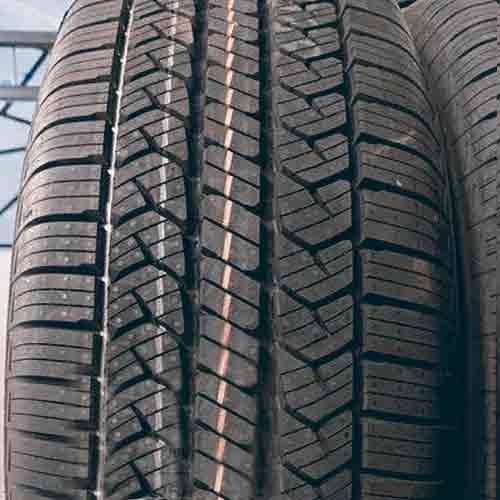So are you ready to upgrade your ride? I’m diving into the General Altimax RT45 which is not just any tire, but really a standout in the grand touring all-season category. It’s all about smooth handling, cool design, and impressive fuel efficiency.
Let’s see what makes this tire a top pick for drivers who want performance without the fuss.

Info on Sizes
The General Altimax RT45 comes in 14 to 20 inches rims with following specs.
- Speed ratings: T, H and V.
- Load ratings: SL and XL.
- Tread depth: 11/32″ on all.
- Weight range: 15 to 31 lbs.
- Warranty: 75k miles for H and T, or 65k miles for V-speed rated sizes
- UTQG rating: 600 and 700 A A.
Let’s start things off with tread design before jumping on the performance sections.
Tread Design
So the Altimax RT45 comes with a very biting symmetric tread pattern, as you can see.

It has 5 total ribs forming 4 pretty straight circumferential channels.
The central most area has squared off blocks, placed at an angle with thick lateral sipes in them.
While the surrounding blocks make “Y” shaped biters, and have more off-set edges. Though they carry similar siping and have chamfered edges too just like the central most lugs.
The shoulder blocks are fairly simple carrying straight lateral sipes and small notches towards the longitudinal grooves they form.
Let’s see how all these design features help this tire when it comes to dry performance.
Dry Performance
So on dry roads, there are two things to look out for, braking and handling. Let’s start with braking grip, or longitudinal traction.
Longitudinal Grip
The longitudinal grip of a tire primarily refers to its braking traction, which is crucially influenced by the tread’s central area. This section is vital as it supports the bulk of the weight when the tire rolls in a straight line.
Here, the new General Altimax RT45 tire performs pretty great, thanks to its sleek, longitudinally-aligned ribs and nearly continuous patterns that maintain consistent contact with the road, thereby increasing both friction and traction.
The tire is thoughtfully designed to strike an optimal balance between biting elements and rubber, providing excellent traction via both the contact patch and the strategically placed in-groove notches. It offers a variety of offset and chamfered edges, along with a blend of linear and wave-like siping, which enhances multi-directional grip, and not just linear.
So I have to say, that the overall improvements over its predecessor are quite noticeable; for instance, it lacks the narrower central rib found on the older version, which contributes to its enhanced performance.
And yes, it’s also lighter, a significant change from the RT43, whose heavier weight and more open tread pattern exerted more pressure on each tread block. And this increased the momentum inertia, resulting in longer stopping times, as I observed in my 60 to 0 mph tests.
But yes, one thing to keep in mind, that while the RT45 shows marked improvements, both models could still benefit from better “on-center” stability, which is the tire’s ability to realign itself smoothly after making a turn.
Lateral Grip and Handling
Handling is a critical measure of a tire’s overall dry performance, encapsulating several key metrics like braking, lateral traction, and steering response. Understanding these aspects involves examining the three phases of a corner.
- Entry Phase: This initial stage often requires braking and occasionally downshifting as the vehicle prepares for the turn.
- Mid-Cornering: Precision in steering and maintaining grip are paramount at the apex of the turn.
- Exit Phase: The focus here is on realigning the vehicle and smoothly resuming acceleration.
The General Altimax RT45 excels in all these stages, particularly noted for its precise steering which enhances the entry into corners.
Its robust braking capabilities and excellent cornering grip, as indicated by lateral g-forces, enable more controlled and efficient mid-cornering. Post-corner, its relatively “heavier” steering provides better on-center feedback, despite there still being room for improvement.
With the RT45 excelling across all these phases, it consistently achieves lap times that are about 0.5 seconds faster on average compared to its latest competitor, the Cooper ProControl.
Wet Performance
Wet performance is fundamentally about how effectively a tire can clear water to maintain grip and prevent hydroplaning. Let’s break this down.
Wet Grip and Handling
The General Altimax RT45 stands out for its exceptional wet performance, outclassing many of its competitors due to its superior water-clearing capabilities.
This ability stems from its well-designed groove and sipe structure. The grooves act as the tire’s primary defense against hydroplaning by pushing most of the water aside. Following this, the sipes—tiny slits on the tread—take over, eliminating any remaining moisture.
This ensures the road is drier and more suitable for the rubber to grip. What makes the Altimax RT45 especially effective is its array of sipes, which vary in angles across different ribs, enhancing multi-directional wet grip.
This design allows for an impressive mix of lateral and directional traction, further boosted by four wide circumferential grooves that remove a significant amount of water right from the start.
Hydroplaning
Hydroplaning resistance is a crucial but often overlooked aspect of tire performance, essential for maintaining control and contact with the road.
It’s measured by how well a tire can channel water through its grooves at various speeds before it begins to float and lose contact with the road.
And here the Altimax 45 performs comparably to other tires in its category, with similar average float speeds in both curved and straight hydroplaning tests.
I mean there’s nothing here to talk about, its all average.
Snow and Ice Performance
While the General tires do not carry the 3-Peak Mountain Snowflake rating, they still perform good enough within their all-season category.
So I have to say that if winter performance is your main concern, consider all-weather options like the CrossClimate 2 or the Nokian SeasonProof, which tops my list for grand touring tires.
Anyways, so the General Altimax RT45, however, marks a significant improvement over its predecessor in snow conditions, excelling in nearly all related performance metrics.
This is largely thanks to its complex secondary groove patterns designed for both noise reduction and effective snow engagement.
These grooves enhance snow-to-snow contact, crucial for traction in lighter, fluffier snow. Snow tends to adhere better to itself than to rubber, giving the RT45 a traction advantage in such conditions.
Furthermore, the newer Altimax tire features more effective in-groove notches and a shoulder design with offset edges, which help move snow aside and improve snow acceleration.
Wear Rate
Discussing tire wear involves several key factors, such as the tire’s weight, composition, and tread depth. The General Altimax RT45 exemplifies notable advancements in this area over its predecessor.
But what has contributed to this improvement?
A major factor is the newly engineered contact patch, now designed with slightly rounded edges. This design feature promotes a more uniform weight distribution across the tread. Consequently, each tread lug experiences reduced pressure during road contact, which diminishes rolling friction and slows the wear rate.
Moreover, the Altimax RT45 is remarkably lighter than its previous version, making it one of the lightest tires in the grand touring all-season category. This reduction in weight contributes to its durability.
Additionally, the tire features an updated rubber compound that more effectively dissipates heat—a crucial improvement since heat accelerates tread deterioration.
Fuel Economy
Fuel efficiency in tires is influenced by several factors:
- Tire Weight: Both the internal and external structures contribute to the tire’s overall weight, impacting fuel efficiency.
- Rolling Resistance: This measures how well a tire maintains contact with the road surface without excessive drag.
- Rubber Composition: The inclusion of specific polymers can improve fuel economy while ensuring adequate grip.
The General Altimax RT45 shows improved fuel efficiency over its predecessor, primarily due to its stiffer rubber composition and lighter structure. Unlike the older Altimax RT43, the newer RT45 does not use the Twin Cushion Silica Tread Compound. While this change might slightly reduce comfort, it enhances fuel efficiency.
Wrapping Up
So overall the RT 45 tire does pretty great in almost all conditions.
It excels in longitudinal grip due to its redesigned tread pattern and lighter weight, enhancing braking traction and reducing wear.
And in handling, it demonstrates precise steering and robust braking, particularly during corner entry and mid-cornering phases, leading to consistently faster lap times compared to competitors.
Moreover, in wet conditions, the General’s tire again provides superb traction values.
Additionally, the RT45’s fuel efficiency benefits from a lighter structure and a revised rubber compound that boosts its economy without sacrificing comfort.